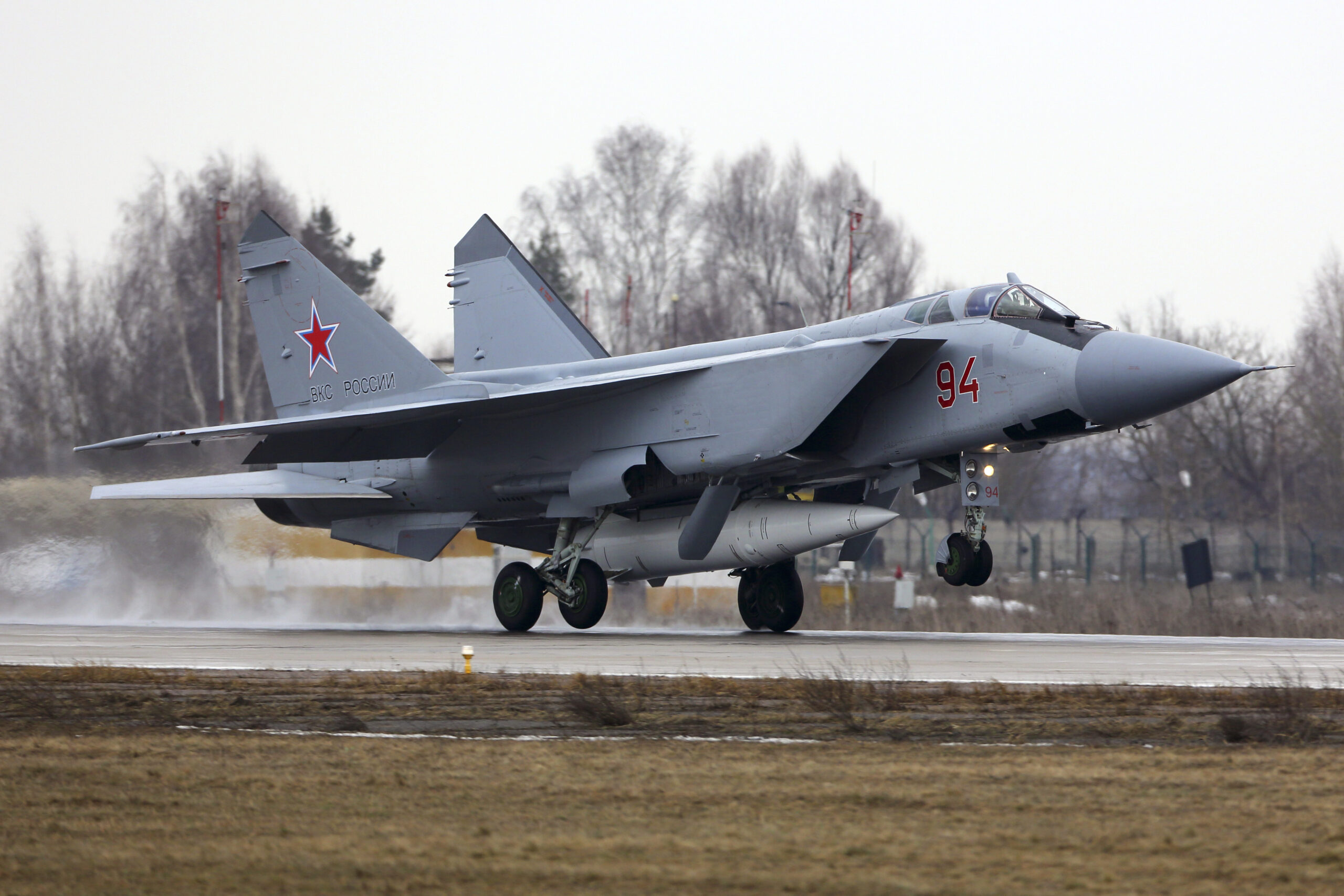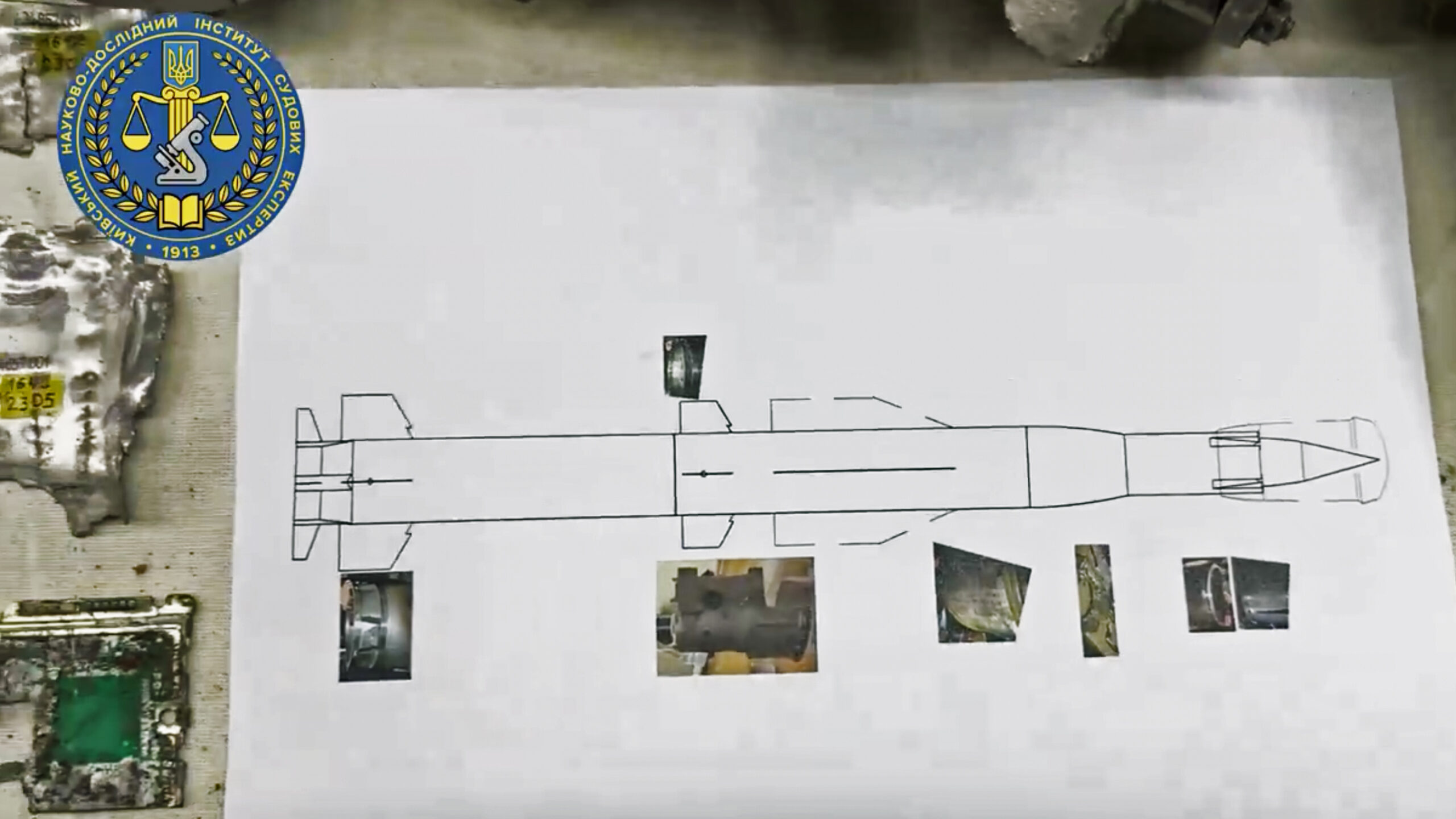Ukrainian scientists say that Russia has used its secretive hypersonic Zircon cruise missile in attacks on at least one target in Ukraine. If that’s the case, this is a highly significant development, with the first combat use of a ‘true’ hypersonic strike weapon. However, there remain many questions about the Zircon’s actual capabilities and its operational status.
An official claim that Zircon (sometimes written as Tsirkon) was used to strike Ukraine comes from the Kyiv Scientific-Research Institute for Forensic Examinations. It is said to be based on a preliminary analysis of missile fragments after a Russian attack on the Ukrainian capital on February 7. That attack killed at least five people and damaged residential buildings and energy infrastructure, according to Ukrainian officials.
The claim was published by Oleksandr Ruvin, director of the research institute, on his Telegram channel. His post included a video (embedded above) of the alleged Zircon wreckage. “In this case, we see elements that are characteristic of the 3M22 Zircon missile. Parts and fragments of the engine and steering mechanisms have specific markings,” he wrote.
Ruvin added that the markings on the Zircon wreckage indicated that the missile had been manufactured recently.
Ahead of the analysis from the research institute, there had been speculation on social media that photos of the wreckage from the February 7 attack on Kyiv may have shown parts of a Zircon. This appears to have been based, to a significant degree, on the missile’s markings, which included ‘3M22,’ the numerical designator for this weapon.
Even before that, however, similar missile wreckage had appeared in Ukraine, apparently around December 30, which included parts that looked very similar to those found after the February 7 attack, down to the ‘3M22’ inscription.
While the wreckage from both of those incidents certainly appears to be from the same type of weapon, we should still treat the findings from the Kyiv Scientific-Research Institute for Forensic Examinations with a vast degree of caution.
Firstly, very little has been provided so far as to explain exactly how the wreckage has been identified as being from Zircon.
Secondly, the Zircon itself remains a very shadowy weapon, with no confirmed photos or official renderings that show it in any degree of detail.

In the past, Russian media have used graphics showing the weapon as a ‘waverider’-type hypersonic missile. This is the same principle used in the U.S. Air Force’s experimental X-51 Waverider, in which supersonic shockwaves are used to maintain the flight vehicle’s lift and stability. To achieve this, a conventional rocket motor is understood to bring Zircon to the required speed and altitude, before an air-breathing scramjet high-speed engine takes over.

However, the Kyiv Scientific-Research Institute for Forensic Examinations shows the alleged Zircon fragments laid out against a line drawing of a supposed 3M22 Zircon missile that looks very different.
Rather than the type of pronounced nose that is normally required to ride that wave, the missile appears to have more in common with a very high-speed ramjet-powered design. The two-stage weapon features a cap over the nose that likely conceals an annular air intake, which feeds the main engine once the first-stage booster falls away. A similar approach was used in the Boeing HyFly, a demonstrator for a hypersonic ramjet-powered cruise missile.

Again, we cannot say for sure how accurate the Ukrainian drawing is or what intelligence it is based on.
Putting these issues aside for a moment, it certainly wouldn’t be totally unimaginable for Russia to have exposed Zircon to combat, even if it’s not yet in widespread operational service. Russia has long used combat environments to test new weapons.
Also, while Zircon is best known as an anti-ship weapon, it does have a land-attack role. The war in Ukraine has already seen Moscow’s forces use other types of anti-ship missiles against targets on land. Examples include the Bastion-P, Kh-22/32, and, apparently the Cold War-era Utes. All of these missiles are primarily intended to attack surface vessels but are at least dual-use or can be repurposed to strike certain static ground targets.
The opportunity to test the missile against powerful air defenses — including Western-supplied surface-to-air missiles — may have been too good to pass up. This is especially true given the hypersonic performance of Zircon — the Russian military claims it can reach speeds of Mach 9.
On the other hand, exposing Zircon to these systems, especially the high-end radars they leverage would be a major intelligence risk. Seeing the missile in action via its radar track telemetry would provide immense insights into its true capabilities and signature. This would help Western intelligence to come up with ways to better defend against it. If Russia already thought this type of data had already made it into its adversaries’ hands, then that risk would be significantly less. Still, the number of sensors deployed around Kyiv, as well as adversary space-based and airborne systems staring at the area with great interest, would surely provide unprecedented data in terms of fidelity.
In the meantime, there is also a question about how the Zircon missiles would have been launched against targets in Ukraine.
As far as Russia has claimed, Zircon has to date only been deployed on Russian Navy Admiral Gorshkov class frigates, none of which are currently present in the Black Sea area. Other surface vessels are reportedly being modified to launch the missile, while new warships and submarines are set to receive it as they are built. Even if any such vessels were already fitted with Zircon, they are also not known to be in the region.

It is possible that a Black Sea Fleet corvette might have been adapted to fire Zircon on a purely trials basis, something that is a fairly routine part of weapons testing.
A more likely explanation could be that the missiles were launched from some kind of static ground-based test facility. Being designed for vertical launch from a containerized system, it shouldn’t be too difficult to assemble a test rig of this kind.

There have been unconfirmed rumors that the missiles were fired from vertical launch containers in Russian-occupied Crimea. However, with a claimed range of 625 miles, Zircon test launches could also have been conducted from deep within Russia’s true borders.
Regardless of how it might have been delivered, if it stacks up, the use of Zircon would be significant. It would indicate not only the inaugural combat use of Zircon in any manner, including in the nearly two-year-old war in Ukraine but also the first time a hypersonic weapon in this category has been employed in combat by any nation.
Russia has made use of the air-launched Kinzhal missile, often described as a hypersonic weapon, against targets in Ukraine, apparently with only mixed success. However, Kinzhal is an air-launched ballistic missile — an evolution of the Iskander-M short-range ballistic missile. So, while it can theoretically reach speeds over Mach 5 during the terminal attack portion of its flight, it is not in the same class as a true hypersonic weapon. It can maneuver, to a degree, but the limitations to its ballistic flight profile make it more predictable and easier to intercept compared with true hypersonic missiles, and Ukraine claims to have downed several examples.

The Zircon, with its sustained hypersonic speed and maneuverability, should present a much greater challenge to Ukraine’s air defenses. Its velocity greatly reduces the amount of time it takes for the weapon to reach its target, limiting the amount of time defenders have to react. In particular, it might be expected to be used against more heavily defended targets, including critical air defense assets themselves, as well as those that are hardened, like fortified command centers.
However, there have been mixed reports about Zircon, its status, operating mode, and especially its capabilities. Normally more than happy to boast of the capabilities of their weapons, Russian officials have admitted in the past that Zircon experienced significant difficulties during development.
In 2020, the Russian government said that the first-ever successful live-fire launch of Zircon had taken place during a drill in the White Sea. The missile was launched from the Admiral Gorshkov, the lead ship of the Project 22350 class of frigates.
The Russian Ministry of Defense says that the video below shows the first launch of a Zircon missile from a ship, the Project 22350 frigate Admiral Gorshkov.

A year later came the first reports that examples of these cruise missiles had been launched from a submarine, namely the nuclear-powered Yasen class Severodvinsk, while sailing on the surface and also while submerged.
Russian officials claimed in January 2023 that Zircon had been introduced to service aboard the Gorshkov, as you can read about here.

Throughout this time, there have been mixed messages about the missile’s capabilities. The Russian Ministry of Defense said that the missile fired over the White Sea in 2020 reached a peak speed of “more than Mach 8” and traveled a total of 280 miles.
A 2022 test in the Barents Sea reportedly saw the weapon fly approximately 620 miles, which would correspond with its claimed maximum range.
Screen captures from a Russian Ministry of Defense video released in May 2022 that claim to show Gorshkov launching a Zircon missile:
So far, it’s unclear if the missile can reach Mach 9, although any speed above Mach 5 is typically defined as hypersonic.
Moreover, Russia has not commented on claims that Zircon has been used in Ukraine, in contrast to its statements about Kinzhal. If it has been used, it would indicate that Moscow is willing to risk potentially highly sensitive technology falling into Ukrainian — and Western hands — in the form of missile wreckage.
It may be that the need to iron out teething problems with the missile has driven its use, at least to some extent. However, the combat employment of Kinzhal does provide a precedent for one of Russia’s more exotic weapons being used in combat very soon after, or even in advance of its operational deployment.
Since the start of the full-scale invasion of Ukraine, there have been repeated questions about the ability of Russia, hampered by crippling international sanctions, to manufacture high-technology weapons without access to Western components. Moreover, the capacity to build such weapons in scale has also been challenged, leading to older and obsolescent equipment being used.
Nevertheless, should the wreckage found in Ukraine prove to be from Zircon, it would undoubtedly be another signal of Russian progress in hypersonic weapons development, an area in which the United States still lags.
“We’re not as advanced as the Chinese or the Russians in terms of hypersonic programs,” U.S. Space Force Gen. David Thompson, Vice Chief of Space Operations, said in 2021, referencing a reported Zircon test that year.
More pertinently, if Russia is indeed using hypersonic cruise missiles in Ukraine, even in a very limited experimental capability, that would pose additional new challenges to Ukraine’s air defenses and new opportunities for foreign intelligence collection.
At this time we see no publicly disclosed definitive proof that Zircon was indeed used, nor can we identify an extremely compelling case for its employment in the conflict, but that could certainly change at any time.
Update, February 14: In its latest intelligence assessment on the war in Ukraine, the U.K. Ministry of Defense appears to support the idea that the Zircon has been used in combat. On X, it states that, in the absence of vessels known to carry the missiles in the Black Sea, the Zircon was likely fired from the land-based K-300 coastal defense system, also known as Bastion.
“It is likely the Russians are testing a newly operational weapon system in a live conflict environment to provide assurance and demonstrate capability,” the U.K. Ministry of Defense concludes.
Contact the author: thomas@thewarzone.com
